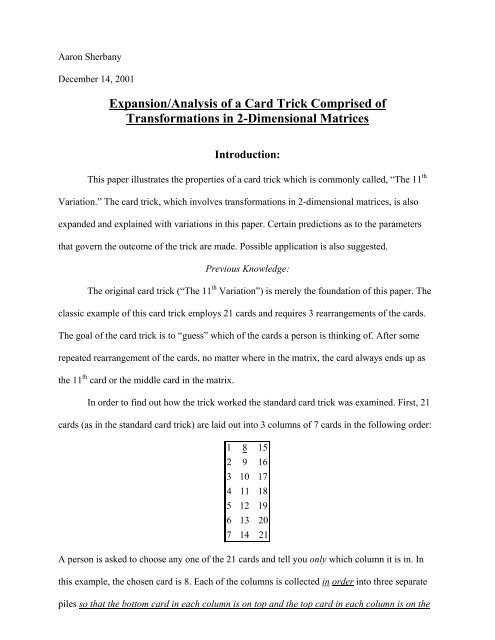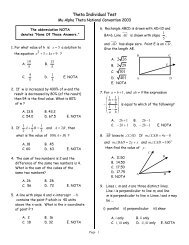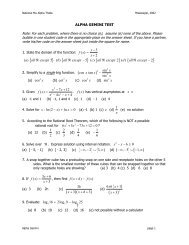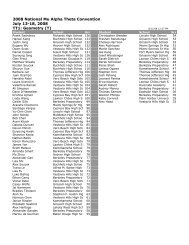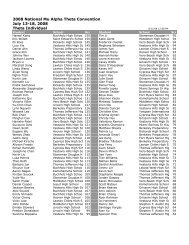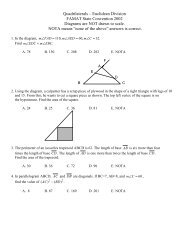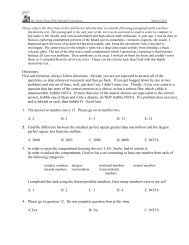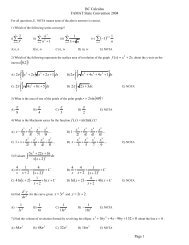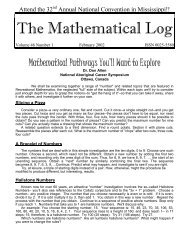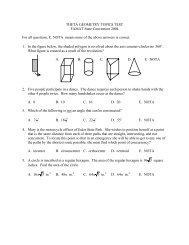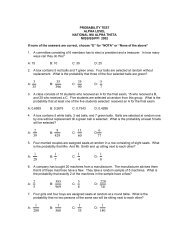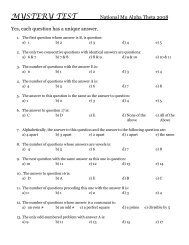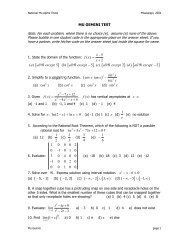Expansion/Analysis of a Card Trick Comprised of ... - Mu Alpha Theta
Expansion/Analysis of a Card Trick Comprised of ... - Mu Alpha Theta
Expansion/Analysis of a Card Trick Comprised of ... - Mu Alpha Theta
You also want an ePaper? Increase the reach of your titles
YUMPU automatically turns print PDFs into web optimized ePapers that Google loves.
Aaron Sherbany<br />
December 14, 2001<br />
<strong>Expansion</strong>/<strong>Analysis</strong> <strong>of</strong> a <strong>Card</strong> <strong>Trick</strong> <strong>Comprised</strong> <strong>of</strong><br />
Transformations in 2-Dimensional Matrices<br />
Introduction:<br />
This paper illustrates the properties <strong>of</strong> a card trick which is commonly called, “The 11 th<br />
Variation.” The card trick, which involves transformations in 2-dimensional matrices, is also<br />
expanded and explained with variations in this paper. Certain predictions as to the parameters<br />
that govern the outcome <strong>of</strong> the trick are made. Possible application is also suggested.<br />
Previous Knowledge:<br />
The original card trick (“The 11 th Variation”) is merely the foundation <strong>of</strong> this paper. The<br />
classic example <strong>of</strong> this card trick employs 21 cards and requires 3 rearrangements <strong>of</strong> the cards.<br />
The goal <strong>of</strong> the card trick is to “guess” which <strong>of</strong> the cards a person is thinking <strong>of</strong>. After some<br />
repeated rearrangement <strong>of</strong> the cards, no matter where in the matrix, the card always ends up as<br />
the 11 th card or the middle card in the matrix.<br />
In order to find out how the trick worked the standard card trick was examined. First, 21<br />
cards (as in the standard card trick) are laid out into 3 columns <strong>of</strong> 7 cards in the following order:<br />
1<br />
2<br />
3<br />
4<br />
5<br />
6<br />
7<br />
10<br />
11<br />
12<br />
13<br />
14<br />
A person is asked to choose any one <strong>of</strong> the 21 cards and tell you only which column it is in. In<br />
8<br />
9<br />
this example, the chosen card is 8. Each <strong>of</strong> the columns is collected in order into three separate<br />
piles so that the bottom card in each column is on top and the top card in each column is on the<br />
15<br />
16<br />
17<br />
18<br />
19<br />
20<br />
21
Sherbany 2<br />
bottom. The piles are stacked so that the pile with the “chosen column” (which contains the<br />
chosen card) is placed between the other two. The deck is turned upside down so that the back <strong>of</strong><br />
the cards are showing. The cards in the stack (which were previously arranged in columns) are<br />
rearranged in rows. The cards should now be juxtaposed in the following fashion:<br />
1<br />
4<br />
7<br />
10<br />
13<br />
16<br />
19<br />
2<br />
5<br />
8<br />
11<br />
14<br />
17<br />
20<br />
Once again, the person is asked to find their chosen card and only tell you the location in terms<br />
<strong>of</strong> which column it is in. The cards are collected in the same order and fashion as before. The<br />
new “chosen column” (containing the chosen card) is placed in a pile between the other two piles<br />
and the deck is flipped (the same procedure as before). Rearranging the cards in rows again will<br />
produce the following layout:<br />
1<br />
10<br />
19<br />
8<br />
17<br />
6<br />
15<br />
4<br />
13<br />
2<br />
11<br />
20<br />
9<br />
18<br />
Again, the person is asked which column is the “chosen column.” Column 1 is placed between 2<br />
and 3, the deck is flipped, and the cards are laid out in rows. Now, the middle card (11 th card) in<br />
the matrix is the chosen card.<br />
3<br />
6<br />
9<br />
12<br />
15<br />
18<br />
21<br />
7<br />
16<br />
5<br />
14<br />
3<br />
12<br />
21
4<br />
11<br />
18<br />
19<br />
6<br />
16<br />
3<br />
13<br />
20<br />
1<br />
8<br />
15<br />
5<br />
12<br />
2<br />
9<br />
10<br />
17<br />
7<br />
14<br />
21<br />
Sherbany 3<br />
Note that in the previous steps, the chosen card progressively moved toward the middle. In this<br />
example (7 row by 3 column configuration), the person conducting the trick must ask for the<br />
“chosen column” at least three times to be sure that the chosen card is in the middle <strong>of</strong> the<br />
matrix. I proved this by trying the trick with each <strong>of</strong> the 21 cards. Depending on their position,<br />
the cards required asking numbers from 1 to 3 to arrive at the center position. Once achieved, the<br />
chosen card will remain at the middle position no matter how many times the conductor asks. A<br />
minimum <strong>of</strong> 3 rearrangements is required to guarantee the chosen card to be the 11 th card<br />
(middle card).<br />
<strong>of</strong> the trick:<br />
Four important questions come to mind that serve as a basis for expansion and variation<br />
1. Is it possible for this trick to work with more or less than 21 cards?<br />
2. Is it possible to make the card appear in another position <strong>of</strong> the matrix?<br />
3. Is it possible to use an even number <strong>of</strong> rows and columns?<br />
4. Can this trick be expanded into 3 dimensional matrices?<br />
Variable/ Term Definitions:<br />
a. Asking Number or Number <strong>of</strong> Askings (variable = n) – the minimum amount <strong>of</strong> times the<br />
person conducting the trick is required to ask for the “chosen column” (in order to be sure<br />
that the card is in the middle position).
. Column Number (variable = c) – the amount <strong>of</strong> columns in the matrix.<br />
c. Row Number (variable = r) – the amount <strong>of</strong> rows in the matrix.<br />
d. <strong>Card</strong> Number (variable = k) – the amount <strong>of</strong> total cards in the matrix ( r × c )<br />
Sherbany 4<br />
e. Asking Set (variable = s) – the number <strong>of</strong> possible combinations <strong>of</strong> rows (with a constant<br />
number <strong>of</strong> columns) that have the same asking number. The end and beginning <strong>of</strong> an<br />
asking set is marked by a thick line over a thin line in the data tables on the following<br />
pages. An example is shown below:<br />
↑<br />
Asking Set<br />
↓<br />
g. <strong>Card</strong> Number Exponent (variable = y) – the exponent that will make a given number <strong>of</strong> columns equal<br />
to a given card number. Ex) y=logck<br />
Observations and <strong>Expansion</strong>:<br />
Asking Number Variations:<br />
After trying the card trick with several different arrangements <strong>of</strong> cards, I realized that the<br />
asking number varies according to the number <strong>of</strong> rows and columns. In order to establish some<br />
type <strong>of</strong> generalization, I looked for patterns in the asking numbers and rows when c was kept<br />
constant at 3 (c = 3 in the original trick).<br />
An example <strong>of</strong> one <strong>of</strong> my trials is shown below using an 11 row by 3 column array. I<br />
noticed that the asking number is 4 rather than 3 (in the original trick).
0 = n<br />
1 12 23<br />
2 13 24<br />
3 14 25<br />
4 15 26<br />
5 16 27<br />
6 17 28<br />
7 18 29<br />
8 19 30<br />
9 20 31<br />
10 21 32<br />
11 22 33<br />
1 = n<br />
1 2 3<br />
4 5 6<br />
7 8 9<br />
10 11 12<br />
13 14 15<br />
16 17 18<br />
19 20 21<br />
22 23 24<br />
25 26 27<br />
28 29 30<br />
31 32 33<br />
The results <strong>of</strong> the other trials are shown below:<br />
c = 3<br />
2 = n<br />
1 4 7<br />
10 13 16<br />
19 22 25<br />
28 31 3<br />
6 9 12<br />
15 18 21<br />
24 27 30<br />
33 2 5<br />
8 11 14<br />
17 20 23<br />
26 29 32<br />
k ( r × c ) r n s<br />
3 1 1 NA<br />
9 3 2 1=3 0<br />
15 5 3<br />
21 7 3<br />
27 9 3<br />
33 11 4<br />
39 13 4<br />
45 15 4<br />
51 17 4<br />
57 19 4<br />
63 21 4<br />
69 23 4<br />
75 25 4<br />
81 27 4<br />
87 29 5<br />
93 31 5<br />
99 33 5<br />
105 35 5<br />
111 37 5<br />
117 39 5<br />
123 41 5<br />
129 43 5<br />
135 45 5<br />
3=3 1<br />
9=3 2<br />
27=3 3<br />
3 = n<br />
1 10 19<br />
28 6 15<br />
24 33 8<br />
17 26 7<br />
16 25 3<br />
12 21 30<br />
5 14 23<br />
32 4 13<br />
22 31 9<br />
18 27 2<br />
11 20 29<br />
Sherbany 5<br />
4 = n<br />
10 6 33<br />
26 25 21<br />
14 4 31<br />
27 20 1<br />
28 24 17<br />
16 12 5<br />
32 22 18<br />
11 19 15<br />
8 7 3<br />
30 23 13<br />
9 2 29
↓ ↓ ↓<br />
243 81 5<br />
249 83 6<br />
↓ ↓ ↓<br />
729 243 6<br />
735 245 7<br />
↓ ↓ ↓<br />
81=3 4<br />
(predicted)<br />
(predicted)<br />
↓<br />
Sherbany 6<br />
In order to test such a large number <strong>of</strong> cards, I used five decks. (261 cards is the highest<br />
possible divisible by 3 (with the joker). The joker was used as a test chosen card). Therefore, I<br />
was able to test 3 columns up to 87 rows. The rest <strong>of</strong> the table was predicted according to the<br />
asking number pattern which is set by rows 1-87. The pattern concerns the asking set value (s).<br />
For example, in the table above, when c = 3 and r = 11…27, then s =9. There are 9 possible<br />
combinations for which the asking number is 3. The number 9 is significant because it is 3 2 . Note<br />
that 3 is the number <strong>of</strong> columns and the exponent (which is 2 in this example) is n – 2. This<br />
pattern is consistent for the other asking sets (see table). Therefore the following equation can be<br />
formed concerning asking sets:<br />
s = c n-2<br />
To see if this equation would remain constant for other scenarios with a different number<br />
<strong>of</strong> columns, c=5 was tested. For the next set <strong>of</strong> trials, I skipped c=4. (The reason I skipped 4<br />
columns is because there cannot be a unique position that is both the vertical and horizontal<br />
median when using an even number <strong>of</strong> rows or columns.) Results when c=5:<br />
c = 5<br />
k ( r × c ) r n s<br />
5 1 1 NA<br />
15 3 2<br />
25 5 2<br />
35 7 3<br />
45 9 3<br />
55 11 3<br />
2=5 0 ×2<br />
10=5 1 ×2
65 13 3<br />
75 15 3<br />
85 17 3<br />
95 19 3<br />
105 21 3<br />
115 23 3<br />
125 25 3<br />
135 27 4<br />
↓ ↓ ↓<br />
625 125 4<br />
635 127 5<br />
↓ ↓ ↓<br />
3125 625 5<br />
3135 627 6<br />
↓ ↓ ↓<br />
50=5 2 ×2<br />
(predicted)<br />
250=5 3 ×2<br />
(predicted)<br />
(predicted)<br />
↓<br />
Sherbany 7<br />
As you can see, the card numbers increase much faster in this chart. I was not able to<br />
discover enough <strong>of</strong> the table with 261 cards this time (I tested up to 255 cards in this case).<br />
However, the pattern from the first table with c=3, helped me predict the rest <strong>of</strong> the n values for<br />
c=5. As in the c = 3 chart, the greatest number <strong>of</strong> cards in a series is equal to the greatest number<br />
<strong>of</strong> rows in the next series. By the means <strong>of</strong> this method, I was able to predict that the n = 5 asking<br />
series ends at 625. Using this information, I calculated the asking set equation. The ratio <strong>of</strong> the<br />
difference in r for each asking set to the asking set value is 2:1. For example:<br />
125 – 25 = 100<br />
100 2<br />
= 50 = 5 × 2<br />
2<br />
Therefore:<br />
625 – 125 = 500<br />
500 3<br />
= 250 = 5 × 2<br />
2<br />
The asking set equation for c = 5 is:<br />
s=5 n-2 ×2
Sherbany 8<br />
At this point I had guessed that the asking set equation c = 7. I renamed the asking set<br />
equation for c = 3 as s=3 n-2 ×1 rather than s=3 n-2 , so that it is easier for comparison. My<br />
predictions are shown below:<br />
s=3 n-2 ×1<br />
s=5 n-2 ×2<br />
s=7 n-2 ×3<br />
s=9 n-2 ×4<br />
To justify these predictions, I charted the results for c = 7 and c = 9. In order to find the<br />
value <strong>of</strong> the asking set, I used the same method that I used for c = 5. The method, once again: As<br />
in the b = 3 chart, the greatest number <strong>of</strong> cards in a series is equal to the greatest number <strong>of</strong> rows<br />
in the next series. c = 7 and c = 9 charts are shown below respectively:<br />
c = 7<br />
k ( r × c ) r n s<br />
7 1 1 NA<br />
21 3 2<br />
35 5 2<br />
49 7 2<br />
63 9 3<br />
77 11 3<br />
↓ ↓ ↓<br />
343 49 3<br />
345 51 4<br />
↓ ↓ ↓<br />
2401 343 4<br />
2415 345 5<br />
↓ ↓ ↓<br />
16807 2401 5<br />
16821 2403 6<br />
↓ ↓ ↓<br />
3=7 0 ×3<br />
21=7 1 ×3<br />
147=7 2 ×3<br />
(predicted)<br />
1029=7 3 ×3<br />
(predicted)<br />
(predicted)<br />
↓
k ( r × c ) r n s<br />
9 1 1 NA<br />
27 3 2<br />
45 5 2<br />
63 7 2<br />
81 9 2<br />
99 11 3<br />
↓ ↓ ↓<br />
729 81 3<br />
737 83 4<br />
↓ ↓ ↓<br />
6561 729 4<br />
6579 731 5<br />
↓ ↓ ↓<br />
charts.<br />
4=9 0 ×4<br />
36=9 1 ×4<br />
(predicted)<br />
324=9 2 ×4<br />
(predicted)<br />
(predicted)<br />
↓<br />
After completing the four tables (c = 3, 5, 7, 9) I observed that:<br />
•<br />
s = c<br />
n−2<br />
c = 9<br />
c −1<br />
×<br />
2<br />
• The highest possible r in an asking set is<br />
n−1<br />
c<br />
Sherbany 9<br />
• The charts serve as a quick and easy reference to find the required asking number<br />
when the number <strong>of</strong> columns and rows is known.<br />
There are many other mathematical patterns and applications that can be created from the<br />
Different Arrangements in 2 Dimensions:<br />
In the original “11 th Variation” trick, the card always appears in the middle <strong>of</strong> the matrix<br />
after a given number <strong>of</strong> askings. The card always appears in the middle because the “chosen<br />
column” is placed as the middle pile. I decided to place the “chosen column” on the bottom <strong>of</strong><br />
the stack. After repeating this 3 times with the 3 by 7 configuration, the card appeared in the
Sherbany 10<br />
upper left corner <strong>of</strong> the matrix. Then, I placed the “chosen column” on top <strong>of</strong> the stack. After<br />
repeating this 3 times with the 3 = c / 7 = r configuration, the card appeared in the lower right<br />
corner <strong>of</strong> the matrix.<br />
The advantage <strong>of</strong> making the cards appear in the corners is so that the trick can be<br />
performed with an even number <strong>of</strong> columns and/ or rows. The conductor can use even and even<br />
or even and odd arrangements such as 4×4 or 3×4. Below is an example <strong>of</strong> a trick which utilizes<br />
an even number arrangement (4×4).<br />
0 = n<br />
1 5 9 13<br />
2 6 10 14<br />
3 7 11 15<br />
4 8 12 16<br />
1 = n<br />
1 2 3 4<br />
9 10 11 12<br />
13 14 15 16<br />
5 6 7 8<br />
3 Dimensional Matrices:<br />
2 = n<br />
1 9 13 5<br />
3 11 15 7<br />
4 12 16 8<br />
2 10 14 6<br />
The 3 dimensional aspects <strong>of</strong> similar rearrangements can also be researched. To get a<br />
card to the center <strong>of</strong> a 3 dimensional matrix, the number <strong>of</strong> rows, columns, and levels must be<br />
odd. An example <strong>of</strong> a 3 dimensional matrix is a 3×3×3 arrangement. To perform the trick in<br />
three dimensions, the conductor must ask for the “common elevated column” which is shaded in<br />
the diagram below. In this example, there are nine cards shaded. Each <strong>of</strong> the nine cards will<br />
Level 1 Level 2 Level 3
Sherbany 11<br />
be placed in a pile between the other two “common elevated columns.” The conductor will lay<br />
out the cards by each level in rows, so that the arrangement will look like the one shown below.<br />
Application<br />
The conductor will continue this<br />
process for a certain amount <strong>of</strong><br />
asking numbers, until the card<br />
appears in the middle layer in the<br />
middle <strong>of</strong> the matrix.<br />
The concept <strong>of</strong> this card trick can be applied to encrypt information in interactive<br />
communication between two or more people. The ideal circumstances for this application are<br />
two people communicating through an interactive website. A diagram <strong>of</strong> an ideal situation is<br />
shown below:<br />
Level 1 Level 2 Level 3<br />
Diagram <strong>of</strong> a 3D <strong>Card</strong> <strong>Trick</strong> - 3×3×3
Sherbany 12<br />
The “sender” is the person who knows the “chosen card” and wants to securely notify the<br />
“interpreter” which is the “chosen card.” Each card has a unique action. The interpreter will<br />
carry out the specified action on the “chosen card” when he/she finds out the location <strong>of</strong> the card<br />
in the matrix.<br />
Sender Receiver/Interpreter<br />
The people will first decide on the layout (rows and columns). The sender will begin by<br />
telling the interpreter which column the card is in by clicking any random card in the “chosen<br />
column.” Then the interpreter will know rearrange the cards accordingly. This process will<br />
continue for the number <strong>of</strong> times necessary (the asking number for the chosen layout) to bring<br />
the card into the middle <strong>of</strong> the matrix, or the corners <strong>of</strong> the matrix.<br />
Any outsider or bystander who is watching will not be able to extract information<br />
because the card that is being clicked by the sender is not the chosen card, but rather a card in the<br />
“chosen column.” The bystander will see the changing matrix because only the “chosen column”<br />
is required by the interpreter and specified by the sender.<br />
The variations <strong>of</strong> the trick that are discussed in this paper can be used to produce an<br />
efficient and secure fashion to transfer ideas between people.
Conclusion<br />
Sherbany 13<br />
This paper explores some <strong>of</strong> the variations <strong>of</strong> a card trick. Mathematical relationships can<br />
be developed to predict how the variations would work. Different arrangements <strong>of</strong> cards should<br />
reveal more patterns and mathematical relationships. Although the card trick is introduced as<br />
“The 11 th Variation,” there are numerous permutations and variations that can be formed by<br />
changing certain properties, such as the number <strong>of</strong> columns and rows. The mathematical analysis<br />
in this paper allows for prediction <strong>of</strong> the parameters that are necessary to predict the chosen card<br />
under different circumstances. The results <strong>of</strong> this paper can be used to produce an interactive<br />
encryption system.<br />
Additional Findings<br />
• Formula to calculate the asking number for even 2-Dimensional matrices<br />
When 49
=<br />
y<br />
c k<br />
y = logc<br />
k<br />
log k<br />
y =<br />
logc<br />
ylog c = log k<br />
y<br />
c = k<br />
• Even Number <strong>Trick</strong>s:<br />
Sherbany 14<br />
log k<br />
The asking number can be calculated by using y = and[ y+ 1 ] = n is shown below:<br />
log c<br />
log k<br />
y =<br />
log c<br />
log 77<br />
y =<br />
Final Formula =<br />
log11<br />
⎡log k ⎤<br />
y ≈ 1.812<br />
n = ⎢ 1<br />
log c<br />
⎥+<br />
⎣ ⎦<br />
n = [ y+<br />
1]<br />
log k<br />
*do not add 1 when the outcome <strong>of</strong> is a whole number.<br />
n = 2<br />
log c<br />
When collecting the card in a regular fashion (bottom card in the “chosen column” on top <strong>of</strong> the<br />
chosen pile) the chosen card will appear in the top left or the bottom right <strong>of</strong> the matrix<br />
depending on where the pile is placed in relation to the other piles.<br />
When collecting the card in reverse fashion (bottom card in the “chosen column” on bottom <strong>of</strong><br />
the chosen pile) the chosen card will appear in the bottom left or the top right if the matrix<br />
depending on where the pile is placed in relation to the other piles.


